Dear Friends, From June 14th till 28th I joined four others aquarists, Pam Chin, Mattia Matarrese, Martin Geerts, and John Dawson, in Malawi with the plan to place markers and anti-netting devices (ANDs) around the Maleri Islands. We were invited by Dimitri Giannakis (owner of the Blue Zebra Lodge) to stay on Nankoma Island at the lodge and we would be using the patrol boat that you all have been contributing for over the years. The boat was in Malawi but not yet at the lake. On June 17th the boat with diesel engine was officially handed over to the National Park. A conference was organized at the Lilongwe Wildlife Center where the Minister of Natural Resources, Energy, and Mining, Hon. Bright Msaka, would be climbing into the parked boat and handed the keys. Martin and I were in attendance as well as about 50 dignitaries from the government, UNESCO, and Lilongwe businesses including, of course, Dimitri and staff personnel from his company, Farmersworld. |
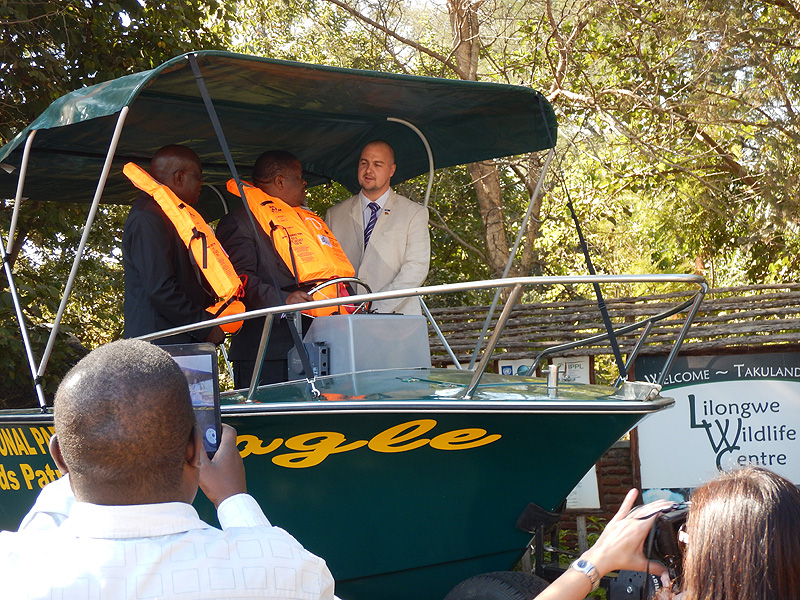 Minister Msaka at the helm of the patrol boat with Steve Roberts, organizer of the handing-over, left of him. Minister Msaka at the helm of the patrol boat with Steve Roberts, organizer of the handing-over, left of him. Photo by Martin Geerts. |
|
Due to the minister’s tight schedule I was given just two minutes to speak to the audience, but managed to explain that the Maleri Islands are the last hold-outs of Lake Malawi National Park and that we may still have a chance to salvage some of its earlier glory (I had yet to dive around the islands and experience the hostility of the fishermen). All other areas of the Park, which has a combined shoreline of about 42 km, have been virtually stripped clean of any food fish because of uncontrolled poaching by local fishermen. The minister is in favor of strictly enforcing the 100 meters no-fishing zone around the islands, and also Leonard Sefu, chairman of Waterlands Trust and former Director of Parks, gave an encouraging address to the attendees. All were in favor of applying anti-poaching laws to the illegal fishermen, but it turns out that the words from the Malawi government need to be accompanied with deeds (see below). |
 The address was an open-air event. Unfortunately the media present was mainly interested in how much money the boat had cost us, much less in the plight of the fish in Lake Malawi. Photo by Martin Geerts. |
The day after the ceremonial hand-over of the boat Steve Roberts, manager of Waterlands Trust, drove us and the boat to the lake where we launched it into the water near Kambiri Point. It behaved well on a choppy lake as we motored to the lodge on Nankoma Island where it will be moored temporarily. |
 The launch took place in very shallow water near Kambiri Point. |
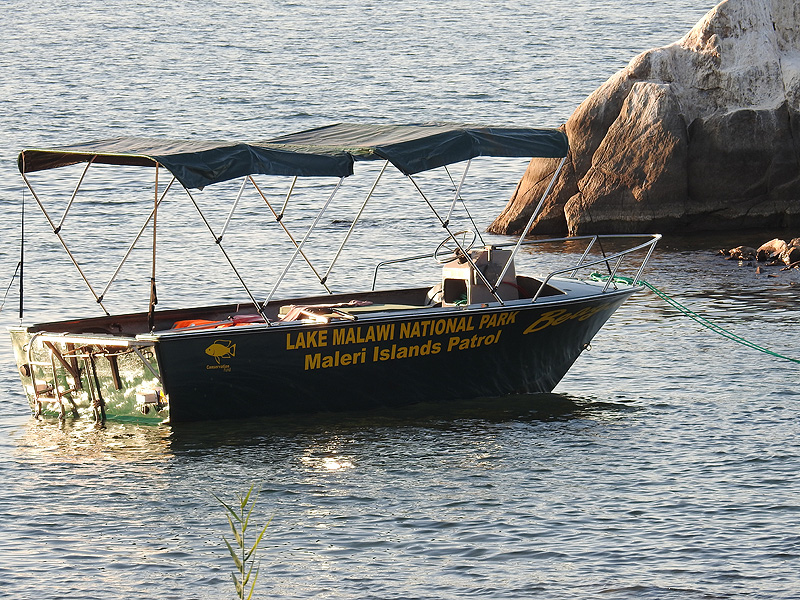 The park boat anchored in front of the Blue Zebra Lodge; not an ideal situation but Dimitri is working on a ranger station on Maleri Island where the boat ultimately will be anchored. |
As part of our program we would first place simple buoys to demarcate the 100-meter no-fishing zone around the three Maleri Islands. Matt and Estelle, managers of the Blue Zebra Lodge, had already prepared 120 buoys from foam-filled plastic water bottles that have a little yellow flag at the top. In the past two years, Matt had placed two dozen, large, metal buoys for demarcation; however, all but two had been removed by the fishermen. The idea was that the cheap and simple buoys would have no value to the local fisherman and at the same time we would not have to invest too much funds. Each buoy would have its own “anchor” in the shape of a football-sized rock and we therefore spent a whole morning collecting rocks and tying twine around each so that we could affix the buoy. |
 Pam, Mattia, John, and Ad preparing “anchors” for the simple buoys. Photo by Martin Geerts. |
After we had about 25 rocks ready to employ we sailed out in the afternoon and started on the northern shore of Nankoma. With a rangefinder I had brought along we could rather quickly gauge the distance from shore and placed 13 buoys about 50 meters apart around about 1/3 of the island before it became too dark to continue. |
 Mattia tying the line from the anchor to the buoy, a plastic bottle filled with foam and a wire through it with a small yellow flag on top. |
The following day we prepared another 25 rocks like we did the day before, and sailed out on midday to discover that the fishermen had already removed 12 of the 13 buoys we had placed a day earlier. Only the one close to the lodge was left in place. Needless to say that we were very disappointed by the fishermen’s hostility for something that would not hinder in any way their fishing efforts. We aborted our mission since it proved futile. All the while we were cruising around the islands we saw fishermen operating within the no-fishing zone and on one occasion when Matt approached them, they just reacted as if they had the full right to fish or camp there and Matt had to f*ck off. |
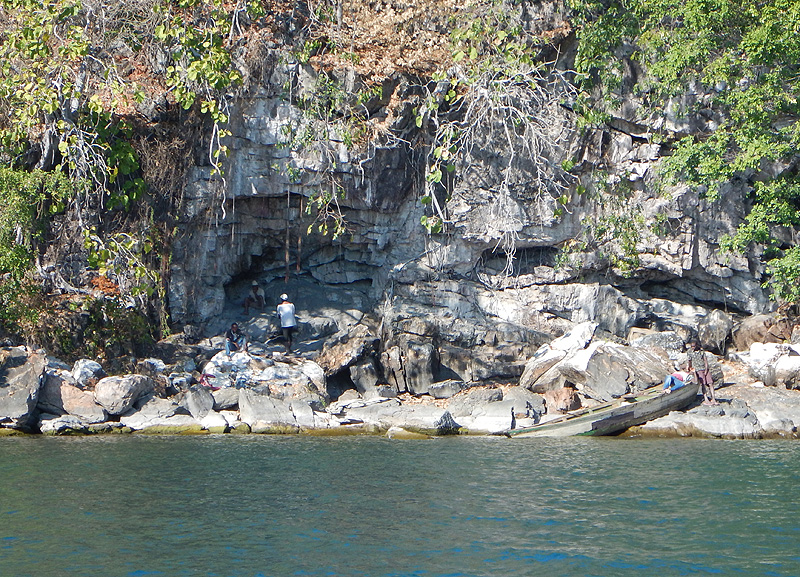 Fishermen illegally camping on Nakantenga Island. Photo by Mattia Matarrese. |
Fishermen hauling a net in the 100-meter no-fishing zone in Bata Bay of Maleri Island. |
While we were in Lilongwe we had taken 5 ANDs which we were planning to place at Nakantenga Island which is the furthest away from the lodge. However, with the present attitude against just a demarcation buoy and still in my mind the hostilities of last year, where a dozen policemen in full riot gear had to protect Matt and Estelle at the lodge (see previous update), I refrained from placing ANDs. I wouldn’t want to have the responsibility of violent fishermen, enraged from losing their nets, attacking the lodge and the people there. The Maleri Islands have six rangers appointed by Parks who, however, stay at a facility on the mainland about 7 km away. Although they appear to only patrol the waters for illegal fishing 2-4 times a month they are not to blame for the current situation whereby fishermen completely ignore regulation and continue to fish and camp in the park. The fishermen who own boats and nets have become, over the years, powerful people and are more or less above the law. Last year when three of them were jailed because of illegal fishing in the park, they managed to turn the whole village against the police and forced them to release the three men. It is the weakness of the District Commissioner and the unwillingness of the government to intervene in such situations that bolstered the brutality and aggression of the local fisherman. We cannot blame the fishermen who work for the boat owners as they are hungry and need to take care of their families. Also because fishermen have been over-fishing Lake Malawi for about 30 years, stocks of food fish have experienced a sharp decline. The decline is so bad that even in park waters no longer sufficient utaka can be caught. This in turn adds to the aggravation of the fishermen who “logically” put the blame on the lodge owners as they see no others to put it on. The last few months the park rangers had made no more arrests because they saw the futility of it all and didn’t want to add to the animosity already present. Two days after our futile mission placing cheap buoys the park rangers arrived from the mainland and brought us 20 real buoys that we could tie to existing rocks underwater. There was still the heavy gauge stainless steel cabling we had purchased years ago for the ANDs and each buoy was tied to a 4-meter length of the heavy cable with a thick rope at the bottom to be tied to underwater rocks. We spent two days placing these improved buoys all around Nankoma Island—see Google Earth shot. |
 Mattia and Ad preparing a demarcation buoy for placement. Photo by Pam Chin. |
The clip shows how we tied the buoy to existing rocks. Notice the murky water. |
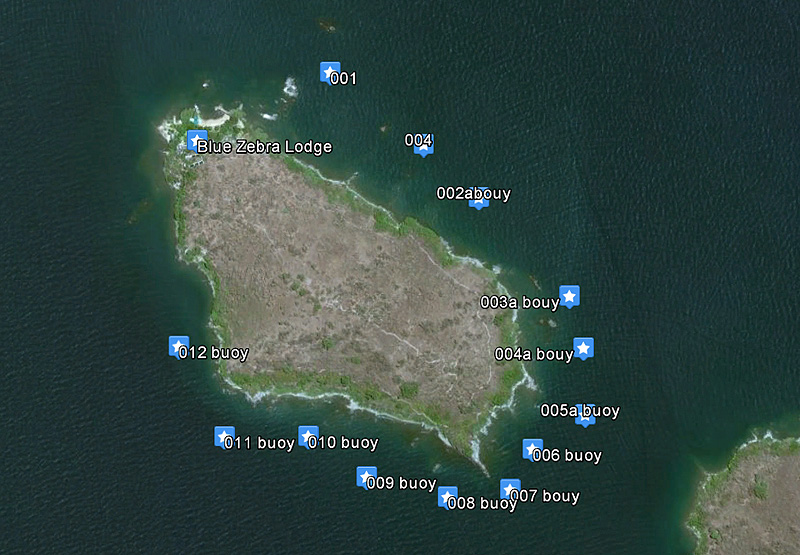 These are the positions of the permanent buoys we placed around Nankoma Island. These are the positions of the permanent buoys we placed around Nankoma Island. |
|
At most places the 100-meter line is still in shallow water not much deeper than 8 meters, but when we were placing them at the southeastern side of the island there was a spot 12 meters deep. Not a problem of course, was it not for the fact that it was pitch-black at a depth of 10 meters! I could not see my hand before my eyes and needed a light to continue. It was 3 pm and light would penetrate normally to at least 35 meters (Nankoma Island) at that time of day. The last few years, visibility at the Maleris has declined dramatically and Matt told me that it rarely is more than 5-6 meters. I know that during the rainy season the viz can be less than 1 cm(!), but it was mid June and there was very little rain last season. In fact Malawi is in a drought right now and farmers have lost their crops because of the lack of rain. Also the lake level was very low; and that is just before the windy season starts. It is expected to drop by more than a meter before the next rains in December. The last two days we spent at Cape Maclear and dived at Zimbawe Rock, Thumbi West, and Otter Island, but the visibility was never more than 5 meters. There are several possible factors playing a role in the present murkiness of the waters in the southern portion of the lake, but in my opinion the over-fishing, actually the virtually complete removal, of the plankton-feeding cichlids of the water column has left more plankton in the water. The dense plankton blooms prevent light from penetrating to deeper layers and will force herbivores from the deeper rocky habitats to move to shallower water or to perish. A similar scenario caused Lake Victoria to collapse. Another factor that may play a role is fertilizer-enriched runoff from farmlands bordering the lake or streams that carry the nutrient-enriched water to the lake. In the southeastern arm of the lake, Maldeco, a company that first depleted the chambo (mainly Oreochromis karongae) stocks, now is involved in chambo farming in 48 huge cages floating in the lake. The feed and the waste emanating from these cages must be substantial as 750 metric tons are reportedly produced yearly. All this provides food for the algae to bloom with no fish to eat it. A few fishermen still catch chambo but nowadays a colored male has a length of about 15-20 cm while the species normally grows to a length of 30-35 cm. Small, mature males is a sign of a deficient population that lacks large, strong males allowing younger fish to mature early. I just hope that the situation in other parts of the lake is less severe. The new president of Tanzania, John Magufuli, appears to be a strong proponent of wildlife protection and supports local authorities when dealing with illegal fishing activities such as using beach seines. To bolster his efforts in protecting biodiversity in Lake Tanganyika he has installed two more fisheries stations there (Kasanga and Ikola). I am not aware how the situation is along the Tanzanian part of Lake Malawi, but for Lake Tanganyika the new regulation entails a 2000-meter no fishing zone! Yes, illegal activity is still common along the lake’s shores, but the new fisheries officers have to produce results else they will be replaced. Magufuli is sometimes referred to as the “bulldozer president”, but Africa certainly could use more of his caliber. When I started to visit the Zambian portion of Lake Tanganyika in the early 1990s the sand-dwelling cichlids were already eradicated from the sandy shores to a depth of about 10 meters. This was due to the intense seining efforts of the local fishermen in the 70s and 80s. The only places left to see sand-dwellers was either in water deeper than 10 meters or, for those species that only live in shallow sandy habitats, in sandy areas with large boulders preventing seines from being pulled ashore. A similar scenario had taken, or was taking, place in all other parts of the lake. A very pleasant surprise, therefore, was to find that a reversal of the situation appears to be taking place in some parts. Early June Martin, John, and I traveled along the Tanzanian shores of Lake Tanganyika and in particular along the shores of Mahale National Park. This park mainly protects the chimpanzees but includes a 2000-meter zone of the lake as well. The last 10-15 years park rangers have been very effective in repelling fishermen from park waters with burning boats and nets, and jailing perpetrators. The effect of a decade of no seining or fishing in near-shore waters was clearly visibly when I snorkeled off the beach at the park’s camp site. I saw hundreds of sand-dwellers such as Ectodus sp. ‘north’, Callochromis pleurspilus, Enantiopus melanogenys, Xenotilapia ochrogenys, and even a Bathybates graueri in water less than six feet deep. In the 30 years that I have been visiting Lake Tanganyika I had never seen this in a pure sandy habitat. So it looks like that when they finally stop a half century of plunder and extraction, populations of various species may bounce back. |
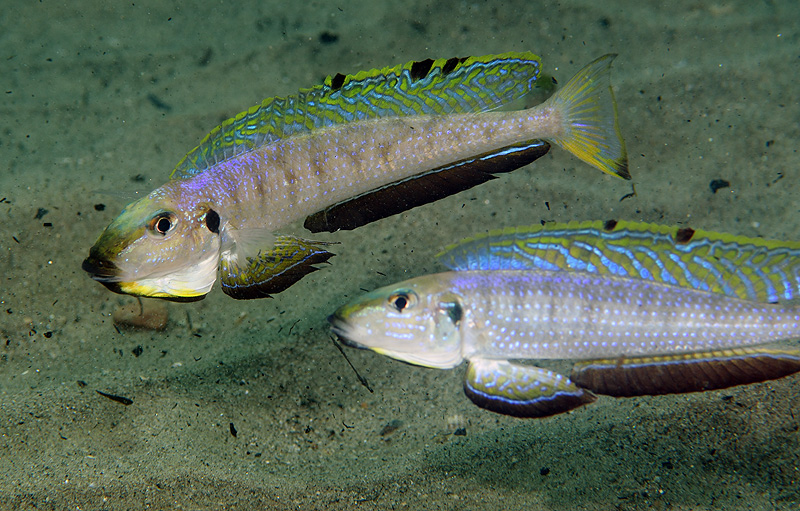 Enantiopus melanogenys males in water less than six feet deep along the Mahale shore. |
|
Since Louise Horsfall was so adamant earlier this year to involve fisheries in the extraction of cichlids from the lake, she and Chris had a surprise visit from a delegation of the fisheries department all the way from Dar es Salaam early April. Louise had sent them a letter explaining how concerned we all are about the extraction of a number of species and that there was no control preventing their exportation from the country. The officials were deeply concerned about how things happened with the nine different teams exporting fish from the lake and asked for help. Not a single one of them had ever seen a photo of a Tanganyika cichlid and Chris suggested that we make a sort of flip file with the endangered species and spread that among all fishery stations as well as the guys at the airport. In the meantime we have made such a file and many sets have been printed and laminated, and brought to Dar es Salaam. The Fund has also sent 12 copies of my Tanganyika book to be distributed to all fisheries stations along the lake. Chris further writes: “As a final farewell, I showed him [Mr. Bugoma, head of fisheries] our tanks and told him that you and the foundation had paid for them. He asked why you would do that and I said that it was all the people who know and understand what is happening here, are concerned that there are four species that we all think might become extinct, so we wanted to keep some here to ensure that they don’t. He was alarmed and concerned, and I think it really helped him get an understanding of how serious the matter is and how worried we all are.” Needless to say that the fisheries department is totally on our side and we have to support them with any suggestions about how to control the export of rare species without jeopardizing the ornamental fish business in Tanzania as a whole. After a setback earlier this year when Chris discovered (in time, fortunately) that the tower he had constructed to hold the 5000-liter container would not hold a full tank indefinitely, he had to tear it down and construct another one with a rock base and concrete blocks (see photo). |
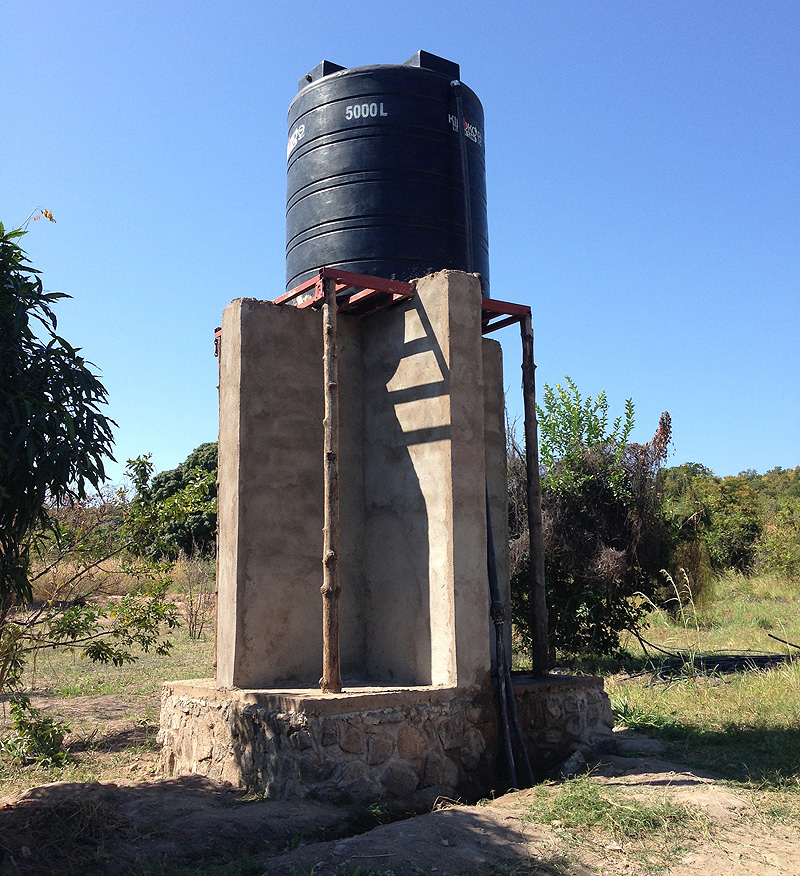 The new water tower supplying the breeding tanks with fresh lake water. Photo by Louise Horsfall. |
|
He also installed the solar pump and set up a solar panel to drive the pump. It is astounding to hear that the pump delivers 35,000 liters a day, seven times the tank’s capacity! So there will be ample water changing when all is up and running. |
 In contrast to the drought situation in Malawi, Lake Tanganyika received more than a normal amount of rain this year. The solar panel to power the pump, which was placed early in the year, now sits in the water. Photo by Louise Horsfall. |
|
Chris also welded the shade covers for each of the eight tanks, however, when he filled them up it turned out that the builder had forgotten to waterproof the bottoms of each tank… They leaked about a foot of water overnight. So now Chris is drying out the tanks so that a new waterproofing can be applied to the bottom of each. Slowly, slowly, but we are getting there. |
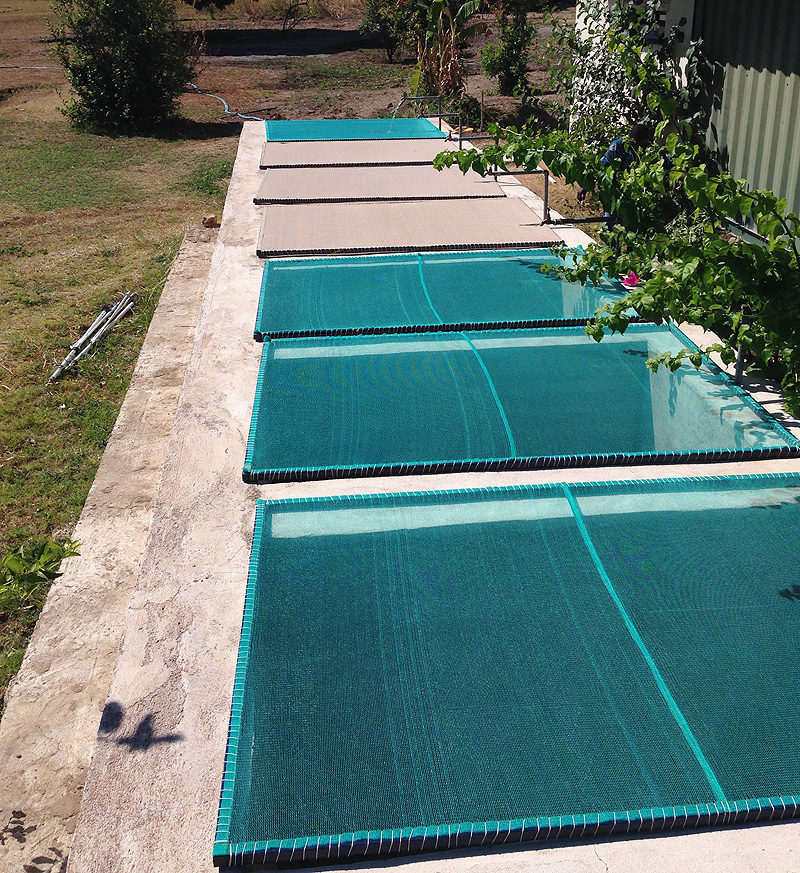 If the bottom of the vats would have been watertight there would already have been fish in them. Now they have to dry out before waterproof cement is poured on the bottom. Photo by Louise Horsfall. |
|
Mattia Matarrese is a very dedicated fundraiser and together with the Perth Cichlid Society (Australia) a total of $2400 was donated to the Fund! He also volunteered placing buoys in Malawi this year (he actually did most of the work) and donated two additional pneumatic drills and a small drone with which Matt at the Maleri islands can observe illegal fishing activities. Thank you, Mattia, for all your support! An auction organized by Wojciech Sierakowski for Klub Malawi in Poland produced $826 for the Fund! Thank you, Wojciech! Several other concerned aquarists have contributed in an important way to the cause and although I have mentioned and thanked them before I would like to thank them again for their continued donations. Thank you, Steve Edie, Christian Alfredson, and Patrick Tawil! Last but not least I would like to thank Kelly Randall and Omega One for their sustained support of the Fund by contributing a portion of each package of Frozen Cichlid Formula! There are more developments that I need to report about, such as the design of a new program (in Tanzania) involving counting certain species in the lake in order to scientifically document possible declines and the cooperation of a new breeder in Malawi for breeding and reintroducing endangered cichlids, but I want to save that for the next update when more specific plans have been made. Even with the decline of Lake Malawi I feel we need to make sure that none of the species lost was caused by the ornamental fish industry. As always thank you for your support and concern.
|
